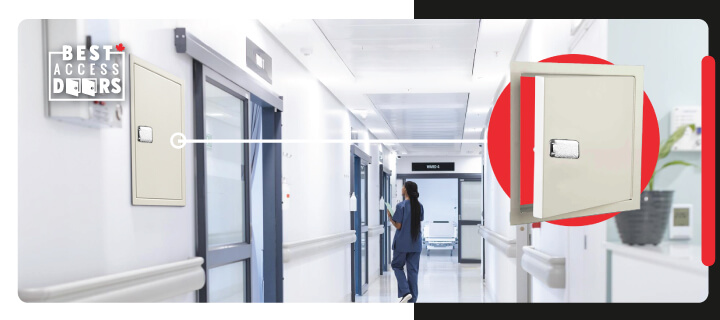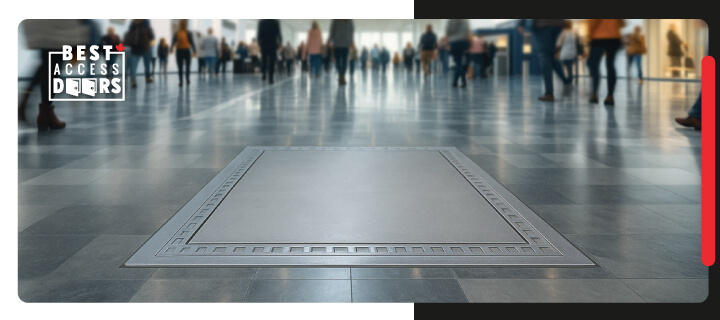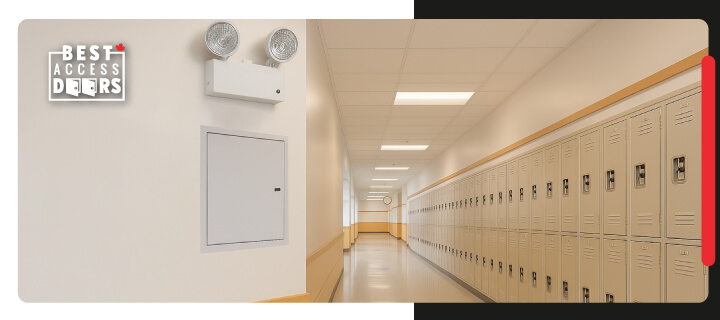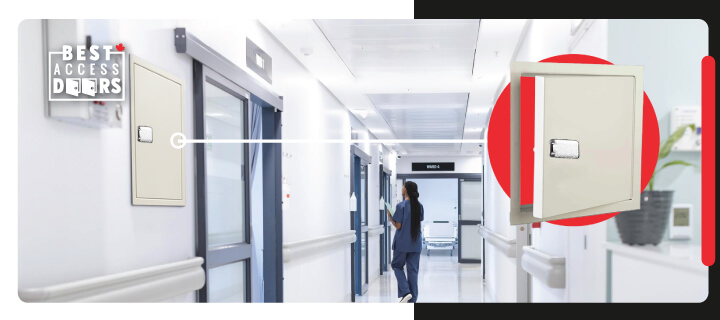How Do You Choose Acoustic Access Panels for Schools, Airports, and Clinics? Posted by Best Access Doors Canada on 13th Oct 2025
Focus on models that effectively control background noise, protect privacy, maintain sound integrity, and meet the proper qualifications for acoustic performance when choosing acoustic access panels for schools, airports, and clinics.
One model that meets these standards is the BAC-STC Acoustical Access Door, which features an insulated core, positive latching, and an airtight seal that blocks airborne sound transmission in gypsum assemblies, ceilings, and partitioned wall systems.
In this article, we'll discuss how acoustic-rated panels like the BAC-STC enhance sound control in educational, healthcare, and transportation environments.
Why Do Access Panels Matter in Acoustic Design?
Access panels matter in acoustic design because they preserve the sound performance and integrity of wall and ceiling systems. When access points are not properly sealed, even high-performing soundproof wall assemblies can lose their Sound Transmission Class (STC) rating, resulting in sound leaks and reduced speech clarity.
With that, always look for an acoustical access door in Canada that can meet noise control and safety requirements.
Ensure it enhances speech clarity and reduces reverberation in classrooms, allowing teachers and students to communicate with ease. It should keep sensitive conversations confidential in healthcare facilities and manage ambient noise, so announcements stay clear in airport terminals.
Designing for acoustic excellence? Request a quote for the best acoustical smoke vents and access doors that align with your specifications.
Where Should Acoustic Panels Be Placed in Typical Wall/Ceiling Assemblies?
Acoustic access panels should be strategically located where maintenance access is essential, but never at the expense of sound isolation. Placement depends on your assembly type:
Gypsum Wall Assemblies
Panels should be positioned away from corners or intersections where vibration transfer is highest. Use airtight gaskets and sealants to maintain the wall’s STC value and prevent sound leakage.
Ceiling Systems
Place the soundproof access panel between structural supports and ensure its frame aligns flush with surrounding tiles to eliminate flanking paths and maintain acoustic integrity.
Multi-Layered or Insulated Cores
Install panels with mass and insulation properties that match the adjacent wall to improve sound isolation and maintain overall acoustic performance.
Related post: Soundproof Access Doors: Best Uses for Noise Control in Architecture
What STC Rating and Features Should You Look For?
Look for acoustic access panels with STC ratings and performance features that match their environment's specific sound control needs and the adjoining partition’s rating.
Measure how effectively a structure reduces airborne sound. Remember, the higher the rating, the greater the level of sound isolation.
Different spaces demand different levels of acoustic performance:
- Residential and Similar Institutional Occupancies – Canada’s NBCC (2020) requires a minimum partition rating of ASTC 47, equivalent to approximately STC 50 in laboratory conditions, to account for sound flanking and real-world installation limits.
- Hospitals and Schools – Acoustic recommendations typically range from STC 55–60 for patient rooms, classrooms, and other sensitive spaces to ensure privacy, comfort, and effective noise control in learning and healthcare environments.
- Airports – Internal areas such as terminals and administrative spaces aim for STC 50–55 to manage background noise and maintain speech privacy. In contrast, exterior envelope assemblies exposed to heavy aircraft noise may require higher ratings for greater sound isolation.
When evaluating products, prioritize features that directly influence sound performance and durability:
- Insulated Core – Increases mass and improves sound absorption by reducing airborne noise transmission through the panel, enhancing overall acoustic performance.
- Airtight Seal – Eliminates flanking noise paths and prevents sound leakage around the panel’s perimeter, preserving the acoustic integrity of the wall or ceiling assembly.
- Positive Latching – Keeps the panel tightly closed under pressure changes, preventing vibration, rattling, or unintended openings for consistent sound isolation.
How Does BAC-STC Support Classroom, Terminal, and Clinic Requirements?
The BAC-STC Acoustical Access Door supports classrooms, terminals, and clinics by delivering superior noise control, durability, and privacy. It meets the distinct acoustic demands of each environment through precision engineering and verified performance.
Providing Superior Sound Containment
The BAC-STC access panel is designed to meet and exceed noise containment and sound transmission blocking requirements. With an impressive STC rating of 64, it significantly reduces unwanted sound transmission between adjoining spaces.
Delivering Premium Build Quality
Constructed from strong materials, the BAC-STC features a 16-gauge steel frame and a 12-gauge steel door for exceptional durability and longevity. Its 1-inch-wide, one-piece trim provides a refined and professional finish suitable for high-traffic environments.
Enhancing Acoustic Insulation
Equipped with 2 3/8-inch acoustical insulation and 3/8 x 1/8-inch closed-cell neoprene gasketing, this STC-rated access door effectively blocks sound transmission, making it ideal for areas where noise control is essential.
Ensuring a Secure Closure
A continuous piano hinge and lift-and-turn compression latch with a chrome finish and cup sealing gasket ensure an airtight and secure closure that enhances sound-blocking performance.
Offering Versatility in Finish
Available in a prime coat with a rust-inhibitive electrostatic powder-baked white enamel finish or an optional stainless steel finish for a sleek, its modern appearance complements any architectural design.
Delivering Unmatched Acoustic Performance
Independently tested to ASTM E1332 and E413 standards, the BAC-STC delivers consistent, verified performance and sets a new benchmark for acoustic control in access door design.
Contributing to LEED Certification
It supports LEED Enhanced Acoustical Performance Credits for schools and other projects emphasizing environmental responsibility and superior sound management.
Ready to order? Contact us today, and we’ll help you through the process. We also offer custom access solutions, so we can customize this panel to meet a specific size for a perfect fit.
What Submittals and Installation Steps Prevent Acoustic Rework?
Prevent acoustic rework by verifying product data, providing detailed drawings, following precise procedures, and inspecting completed assemblies for airtight performance. When installing the BAC-STC Acoustical Access Door, consider the following:
Acoustic Submittals
Confirm the door’s STC rating using laboratory test data and product specifications. Ensure the selected panel matches the STC value of the surrounding wall or ceiling assembly.
Installation Instructions
Follow the manufacturer’s installation guide carefully. The BAC-STC panels must be flush-mounted and sealed with acoustic caulking or gasket material to ensure airtight performance.
For more guidance and information, check out our instructional videos.
Site Confirmation
Inspect the completed installation to confirm that no gaps, misalignments, or improper seals could compromise sound control.
FAQs on Acoustic Access Panels
1. Do acoustic sound panels really work?
Yes, acoustic sound panels work when correctly placed and matched to the room’s purpose. Their effectiveness depends on using the right materials and integrating them into a complete acoustic design rather than standalone fixes.
2. Do I need acoustic panels on all walls?
You don’t need panels on every wall. You only need them where sound reflection and transmission are strongest. In most cases, placing acoustic panels on two opposing walls or a combination of walls and ceilings achieves the desired result. The goal is to balance absorption and reflection, not eliminate all sounds.
3. Can you install acoustic access panels by yourself?
Yes, you can install acoustic access panels if you have basic construction experience and follow the manufacturer’s instructions carefully. Proper sealing, alignment, and fastening are key to maintaining the panel’s STC rating and airtight integrity.
However, because acoustical assemblies are sensitive to gaps and misalignment, it’s best to consult a professional installer or your supplier’s technical team before starting. They can confirm compatibility with your wall or ceiling type and provide detailed instructions.
For more guidance, check out this installation guide for tips on achieving a perfect fit .
To Sum It Up
Acoustic access panels are a smart investment for achieving lasting noise control, privacy, and comfort in sound-sensitive spaces, especially in schools, airports, and clinics. They enhance acoustic performance while supporting a clean and efficient building design.
At Best Access Doors Canada, we build on this commitment by offering STC-rated solutions engineered for reliability and verified for performance, including the BAC-STC Acoustical Access Door.
Call us at +1-888-327-5471 and invest in sound control that delivers long-term value and peace of mind.






